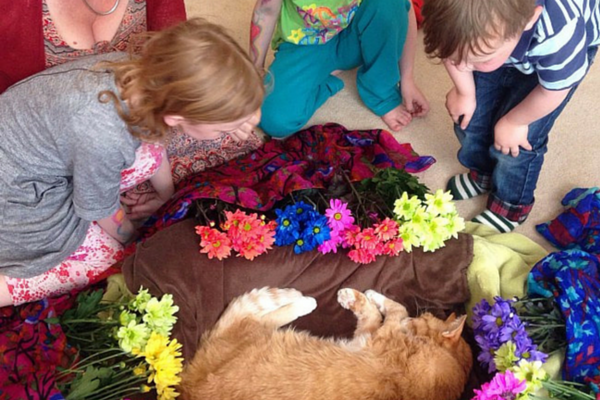
I did a euthanizing ceremony for Artie, a family’s beloved cat. The vet came to the house, so the whole family (including Panther, the other cat) could be part of it. It was both very sad, and very beautiful.
This was the kids’ first experience with death, and their parents wanted it to be normal, safe, and un-confusing. They had prepared the kids well, but still had to work hard to keep what was happening real. When the very kind vet said “And then the medicine will put him to sleep.” Rachel, the Mom, was quick to rephrase it as, “He’s going to be injected with a chemical that will make his heart stop. He’s going to die. He’ll be dead.”
Kids are so literal that they need clear and simple explanations, or their imaginations can run wild and make things worse than they really are. Euphemisms are lost on them, and coded language sends a message that there is something wrong about what’s happening. As well-intentioned as it was, the vet’s statement could easily have led them to be afraid of medicine, or of going to sleep.
Before I arrived, I asked the kids to create a sacred space for the ceremony, and an ancestor altar with photos of people and pets in their family who had already died. During the ceremony, I shared an understanding of death being a journey across a river, from the Village of the Living to the Village of the Ancestors. By assembling the Village of the Ancestors on the altar, it gave the kids a way to understand where Artie was going. He would still be in the family, but just in a different part of it. When they think of their own deaths, they’ll know that they, too, will be safe in that other part of the village, and that they’ll be remembered by those on this side.
The vet gave a first injection of an anesthetic and, as Artie relaxed and fell unconscious, we passed a talking stone around the circle, giving each person a chance to speak to Artie. The first round was for “Thank you”, then “I love you” and then finally “Goodbye.” Panther sat close to Artie, and it looked like he was giving his goodbyes too.
The kids didn’t want to watch the second injection, so I went downstairs with them and told them what would be happening. Upstairs, Rachel and her husband held Artie as he died. Because I was holding the larger space and looking after the kids, Mom and Dad could really let their feelings move, without having to make parenting their first priority while they were saying their final goodbye to Artie.
When Artie was dead, we laid his body in the beautiful box, and the kids came back upstairs. As soon as Artie was settled, Panther jumped in with him and started to nuzzle his body and head bump him. Pets are part of the family, and Panther made it abundantly clear that they bond and grieve just like the rest of us.
Finally we took Panther out of the box, and did a last ceremony to send Artie across the river. With music and tears, we watched as he was received in his new home.
At this point, the kids were no longer really interested in Artie’s body. They wanted to eat cupcakes and play with my rattles. The process had been clear, and complete, and they had a way to understand it. Rather than being clouded in double-speak, or built up as something dangerous that they needed to be protected from, it was simply something that happens in life. A sad thing, but a normal thing.
As ever, I am so grateful to my clients. Being willing to meet death in a healthier way is a powerful healing act. And when they also allow me to share their stories, that healing reaches even more people.
